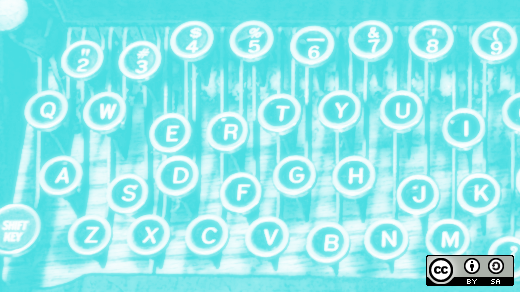Most of us have dozens of fonts installed on our computers, and countless others are available for download, but I suspect that most people, like me, use fonts unconsciously. I just open up LibreOffice or Scribus and use the defaults. Sometimes, however, we need a font for a specific purpose, and we need to decide which one is right for our project. Graphic designers are experts in choosing fonts, but in this article I'll explore typefaces for everyone who isn't a professional designer.
A brief history of fonts

opensource.com
Many years ago, the only typefaces we had for personal use were the monospaced fonts in typewriters. When IBM typewriters came out, you could change the little ball to change the glyphs, but I doubt many people did. We gained access to proportional fonts with the first computers and dot matrix printers, though a glyph printed this way was pretty rough around the edges. Finally, when laser and inkjet printers came out, we had something to rival professional printing presses.
Even before the typewriter, way back when printing presses were first used, fonts were created to resemble old, gothic manuscripts, which most of us now struggle to read. With the introduction of movable type to Europe in the 15th century, businesses sprang up to supply all those cast-metal glyphs to printers. This led to an explosion of printed material, which became much cheaper to produce, and along with that came a marked increase in general literacy. Reading needed to become easier, so Roman typefaces were created; their notable features included serifs and variability in the width of different parts of a glyph, both of which ease character recognition, legibility, and readability.
Various typeface designs began emerging, some with less obvious serifs, more or less variation in stroke width in a given glyph, many meant to be artistic in some way. More conservative fonts, such as Century Schoolbook, emphasized readability. A 19th century offshoot called Egyptian or antique styles had broad, flat serifs.
The 16th century saw the creation of italic typefaces, smaller and slanted, usually with thinner strokes and glyphs closer together. Their advantage was more text could be included on a page with reasonably good legibility. Gradual, continued modification of italics led to a variety of script typefaces, made to resemble handwritten text by appearing to have a continuous stroke from one letter to the next.
In the 19th century, a new kind of gothic typeface came out, which is sometimes referred to as contemporary gothic or sans-serif. As the latter name implies, the serifs are mostly or completely gone, and the stroke width is very even. Although initially meant for use in titles or headlines, some are now used for extended passages of text, as well.
Finally, there are also a number of ornamental typefaces, which are sometimes used for special effects, such as in headlines or business signs.
Font licensing
Fonts have been determined to be "computer programs" and are protected similar to a patent. If you have a font on your system, you might think that you can use it however you wish, but this is where font licensing comes into play. If you have the font, generally it's safe to say that you can use it for your personal work as you wish. But you may not be allowed to give this to anyone else, and for example, embedding the font in a PDF document is giving that to the receiver of the PDF. Some font licenses allow embedding, but will not allow editing of the PDF by someone else, using that font.
There are still a number of businesses, called font foundries, that rely on income from licensing their fonts. For the most part, this doesn't affect us as general computer users when we use a font in a document and print it on our printer. But imagine you have carefully designed a page layout with desktop publishing software and want to use a specific font. To make sure your document looks like you intend when you send it to a commercial printer or another user, you might want to embed the font in your document. If you've selected a commercial font, the font foundry wants to sell it to the printer and therefore may forbid you to embed it, nor will they allow you to copy the font and give it another name.
There are a large number of font licenses out there, many source-specific such as the Adobe licenses. It's not as easy as you might think to find out the details, including the fine print on these licenses. Make sure you look up the license of any font you want to distribute. Most commercial fonts, even if freely distributed, will not allow you to modify or rename the font.
On the other hand, the SIL open font license (OFL) is probably as liberal as you can find. From its website:
The OFL complies with the Open Source Definition:
- free redistribution: #1
- source code: #2
- derived works: #3
- integrity of the author(s) source code: #4 (with the possibility of requiring a name change)
- no discrimination against persons or groups: #5
- no discrimination against fields of endeavor: #6
- distribution of license: #7
- license must not be specific to a product: #8
- license must not restrict other software: #9
- license must be technology-neutral: #10
This means, not only can you use the font in any way you want, you can also derive another font from it and give it another name.
Font management and editing tools
Font management software, as its name indicates, allows you to manage the fonts installed on your computer. In my current Fedora 26, the Font Manager application is automatically installed. It allows me to list all the fonts on my system and disable any fonts I don't need, but otherwise offers limited information. I have also installed Fontmatrix, a Linux font manager that was released in 2007 to great applause and initially rapid development, but stalled at version 0.9.99. Nonetheless it's still useful, offering some of Font Manager's functions plus some information about licensing. Here is the information Fontmatrix provides for Deja Vu Sans:
Not Restricted
This font may be embedded and permanently installed on the remote system by an application. The user of the remote system acquires the identical rights, obligations, and licenses for that font as the original purchaser of the font, and is subject to the same end-user license agreement, copyright, design patent, and/or trademark as was the original purchaser.
Obviously, this still leaves a number of other issues unanswered, such as whether I can edit and make a derivative copy of the font.
For the adventuresome, there is also FontForge, which allows you to edit a font, perhaps adding missing glyphs, or even create your own font from scratch. If you're interested in creating a font, I would suggest taking time to understand what you are in for. There is a great deal of work that goes into type design, and—at the very least—it's worth having a look at some fonts in FontForge to see their complexity. Proportional fonts have varying glyph widths, and you also have to consider the spacing between characters, both of which are incorporated into the design of each glyph.
Choosing a font
If you ever want to get a sense of the depth and breadth and, yes, complexity, of choosing a font, go to the Open Font Library, where you can browse hundreds of fonts; there are more 300 in each of the categories of serif and sans-serif, for example.
Probably a better way to choose the right font for your project is by using a tool like Font Manager or Fontmatrix to examine what you have on your system. Either application allows you to disable fonts you know you will rarely (if ever) need and also to view various font categories to make it easier to compare similar ones.
Because a primary reason we use fonts is to convey information, choose one that supports legibility and readability. In most cases, Roman or serif fonts are the best fit for paragraphs of text, although some sans-serif fonts do well. Being attracted to an interesting-looking script or ornamental font is easy but these should be used only as an attention grabber and, even then, at a minimum.
A good way to examine which fonts you like is to look at books in your personal, business, or public library to see which text has the most pleasant appearance, ease of reading, and other advantages. Even if you don't know the font's name, you should be able to find one with similar characteristics.
Ultimately you want to see the font in action, preferably in work you're doing. Take your font out for a test drive by applying it to a large block or even a few pages of your text. Examine how evenly the glyphs are placed, whether the spacing seems right, etc. (This will probably give you a good sense of why font design is so difficult.) While a program like Scribus allows you to make adjustments to spacing, you don't want to do it on every line or even every paragraph of your document.
Using web fonts
Specifying fonts for web copy is different than using fonts in a desktop publishing or word processing application, where you just select a block of text and apply a font or style. The simplest way to control which font is used on a webpage is to specify a font family in the page style or CSS:
p { font-family: "Times New Roman", Times, serif;}This code tells the page to first try to use Times New Roman, then Times, and finally some serif font.
You could be more specific by using one of the Google fonts:
<link href='https://fonts.googleapis.com/css?family=Sofia' rel='stylesheet'>
<style>
body {
font-family: 'Sofia';font-size: 22px;
}
</style>
You could also embed the font on the server where the page is, then in your CSS:
@font-face {
font-family: Goudy Stout;
font-style: normal;
font-weight: 700;
src: url(GOUDYST0.eot);As you can see, using fonts is not as simple as just choosing something on your system.
Do you have a go-to open source font? Let us know in the comments.







4 Comments